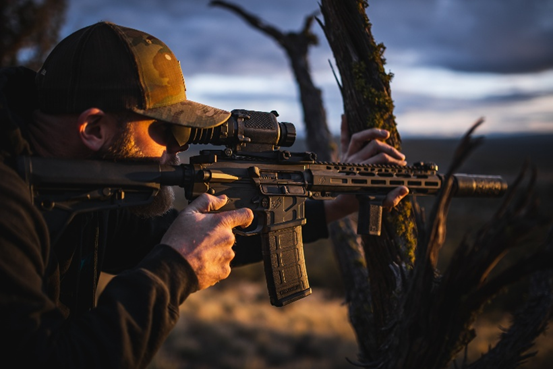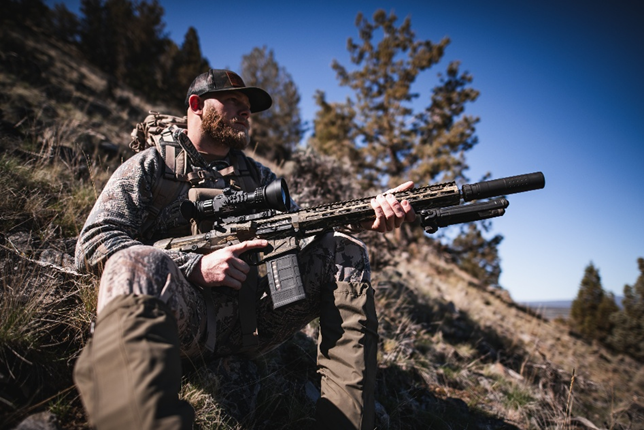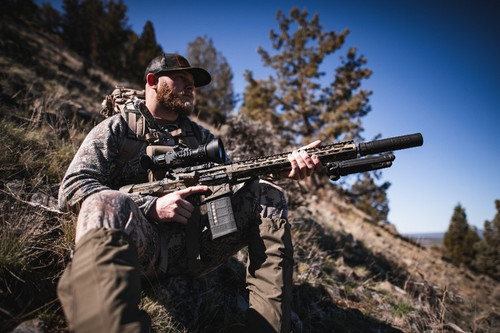Mastering Thermal Scopes: A Complete Guide for Beginners
Feb 5th 2025
Thermal scopes have become a game-changer in many fields, from hunting and wildlife observation to search-and-rescue operations and security. If you're new to this technology, you might be wondering how thermal scopes work, what to look for in one, and how to use it effectively.
Well, you're in the right place! In this guide, we'll break things down for you, from the basics of these scopes to expert tips that will help you get the most out of your gear.
What Is a Thermal Scope?
A thermal scope is a type of optical device that detects heat. It works by capturing infrared radiation emitted from objects (basically, heat energy), which is then displayed as an image on a screen. Unlike regular scopes or night vision optics that rely on ambient light, thermal scopes let you see the heat from animals, people, or objects, even in complete darkness.
What makes these scopes stand out is their ability to see through environmental obstacles like smoke, fog, and light rain. They detect temperature differences and turn them into clear visual contrasts.
For example, a hot object like a coyote will show up as bright white or black, depending on the color palette used. Meanwhile, cooler surroundings will appear dark or an opposite color. This contrast makes it easy to spot targets in low-visibility conditions that the human eye might otherwise miss.
Who Uses Thermal Vision Technology?
Law enforcement officials, military members, security personnel, outdoor enthusiasts, and hunters all use thermal optics for a wide range of applications.
How is Thermal Technology Different Than Night Vision Technology?
Thermal imaging scopes are different from night vision devices. Night vision scopes amplify available visible light, while thermal scopes detect heat signatures that may be invisible to the naked eye. This distinction makes thermal scopes far more effective in not just low-light conditions, but total darkness, especially when there's no light source around.

Key Features to Look for in a Thermal Scope
When you're shopping for a thermal device, there are a few features you'll want to pay close attention to. These will impact the quality of your experience and how effective your scope will be in different situations.
Resolution and Image Quality
The resolution of thermal vision determines how clear the image is. Higher resolution means better image quality and detail, which is especially helpful when you're trying to spot something from a distance.
Look for a thermal device that offers a resolution that matches your needs. If you're using it for hunting, a higher resolution scope will help you clearly identify your target even at long distances.
Field of View (FOV)
Field of view is essentially how much area you can see through the scope at once. A wider field of view is important when you're scanning a large area, whether you're looking for game or monitoring a larger space. On the other hand, a narrower field of view is better for pinpointing specific targets at greater distances.
The key is to find the right balance, depending on your needs.
Detection Range
A good scope should have a solid detection range. This refers to how far it can spot heat signatures. If you're using the scope for hunting, for instance, you want to be able to spot animals at a distance.
Some scopes have detection ranges that stretch hundreds of yards, while others are more suited for closer encounters. Consider your typical use case to choose a scope with the right range.
Battery Life
The last thing you want in the field is for your scope to run out of battery at a critical moment. Battery life can vary widely across different models, so look for one that offers long-lasting performance for the duration of your outings. Some thermal devices come with energy-saving features, like automatic shut-off or low-power modes, to extend their battery life. As well as the ability to connect external power sources to prolong your outdoor adventures via power/battery banks.
Durability and Weather Resistance
If you're using a thermal device outdoors, durability is a must. A scope that can withstand rough handling, wet weather, and extreme temperatures will make sure you're covered in all conditions.
Always check the scope's IP (Ingress Protection) rating, which tells you how well it resists dust and water. A scope rated for "waterproof" or "weather-resistant" will hold up better in the field.
Best Practices for Using a Thermal Scope
Getting the most out of your scope isn't just about buying the right one. You also need to know how to use it properly.
Adjusting Settings for Optimal Performance
Your scope likely has several settings you can adjust to get the best image possible. These settings include brightness, contrast, and color palettes. Brightness and contrast are particularly important in different lighting conditions. For example, when hunting in dense woods, adjusting these settings will help you spot animals hiding in the shadows.
Many thermal devices offer customizable color palettes that let you choose between several heat-signature colors, such as white-hot, black-hot, or red-hot. Experiment until you find the one that works best for your environment.

Target Identification
One of the great things about thermal devices is that they allow you to identify targets based on heat signatures. However, it's important to understand that not all heat signatures are the same. For example, a large animal will give off a stronger heat signal than a smaller one.
Also, objects like rocks or trees can sometimes appear warmer if the sun has heated them up. Take time to identify your target carefully before taking any action.
Proper Mounting and Handling
If you're mounting your scope on a rifle or other equipment, make sure it's securely attached. A loose mount will result in inaccurate shots.
Also, consider the ergonomics of your setup. How you hold the scope will impact your field of view and stability. Make sure everything is comfortable and easy to adjust while you're in the field.
Maximizing Battery Life
Scopes can eat up battery power, especially if you're using them for extended periods. To make sure your scope lasts, try to avoid having the screen at maximum brightness when it's not needed. Use a power-saving mode when possible and bring extra batteries or a portable charger if you're planning a long session.
Common Errors to Avoid When Using Thermal Technology
When you first start using a thermal device, there are a few common mistakes that could limit your success.
Overlooking Calibration
Calibration is key to getting accurate readings from your scope. Before heading out, make sure your scope is properly calibrated to the environment. Without proper calibration, you might miss targets or misinterpret the heat signatures you see. This happens when you power the scope on and it warms up within the first few minutes to get accumulated to the ambient environment.
Ignoring Environmental Factors
The environment can have a considerable impact on how your scope performs. For example, fog, rain, humidity and extreme temperatures can affect how thermal signatures appear. If you're in a damp or foggy environment, expect the images to be less crisp. Knowing how to adapt to these conditions will help you use your scope more effectively.
Improper Maintenance
Taking care of your scope is essential for its longevity. Store it properly, clean the lens regularly, and protect it from physical damage. Never expose your scope to extreme temperatures unless it's rated for such use.
How to Choose the Right Scope for Your Needs
Choosing a scope isn't a one-size-fits-all decision. It depends on how you plan to use it. For example, if you're a hunter, you'll want a scope that offers a good balance of detection range, resolution, and field of view. If you're using it for security purposes, a wider detection range and rugged build might be your priorities.
Armasight offers a variety of thermal devices suited for different applications. Whether you're into hunting, wildlife observation, or tactical operations, we have products designed to meet your needs. Take the time to assess your specific requirements and select a scope that best fits your goals.
FAQs
Why are thermal scopes illegal?
Thermal devices, including scopes, clip-ons, and monoculars are generally not illegal to own in the United States, although certain jurisdictions may restrict their use. Always check to see what the local codes, regulations, and laws are in your area to ensure full compliance.
What are the disadvantages of a thermal scope?
Thermal imaging devices are ideal for improving vision in low-light and even no-light environments. Thermal imaging technology isn't perfect for all situations, however.
Disadvantages of thermal technology include:
- Less detailed digital images compared to some alternatives
- High upfront costs
- Requiring batteries to operate
- Limited effectives in high heat
- Sensitivity to sun exposure
Will a thermal scope pick up a snake?
Depending on environmental factors, thermal sensors may be able to pick up snakes.
What is the lifespan of a thermal scope?
Armasight technology is built to last. We offer competitive warranties on our equipment, ensuring you can see through the night for years.
How does thermal imaging work?
Thermal imaging technology captures infrared light (heat emissions) and transforms it into a visible image.
How does a night vision rifle scope work?
Night vision technology amplifies visible light to improve visibility at night or in other low-light conditions.
What is thermal vision used for?
Thermal vision is used for a wide range of applications, including law enforcement, military missions, security, and hunting.
Where did thermal imaging cameras originate?
Most attribute the creation of thermal imaging cameras to Hungarian scientist Kálmán Tihanyi in 1929. He initially created the technology for military operations, specifically spotting enemy aircrafts.
Can thermal scopes see through walls or other obstacles?
Usually no, thermal technology cannot see through thick walls.
Conclusion
Thermal devices open up a world of possibilities, from improving your hunting success to enhancing safety in security operations. Mastering how to use them takes time, but the effort is well worth it. As you get more comfortable with your scope, you'll start seeing things in a whole new light (well, in a whole new heat signature)!
If you're ready to take your experience to the next level, explore the range of high-quality thermal scopes offered by Armasight. Our products are designed to give you the edge, whether you're out in the wild or on a critical mission. With a little practice, you'll soon be able to spot even the faintest heat signatures and get the most out of your thermal imaging gear.

